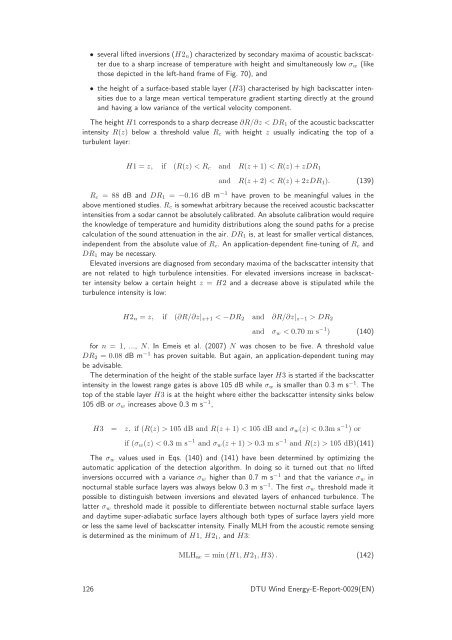Publishers version - DTU Orbit
Publishers version - DTU Orbit
Publishers version - DTU Orbit
Create successful ePaper yourself
Turn your PDF publications into a flip-book with our unique Google optimized e-Paper software.
• several lifted in<strong>version</strong>s (H2n) characterized by secondary maxima of acoustic backscatter<br />
due to a sharp increase of temperature with height and simultaneously low σw (like<br />
those depicted in the left-hand frame of Fig. 70), and<br />
• the height of a surface-based stable layer (H3) characterised by high backscatter intensities<br />
due to a large mean vertical temperature gradient starting directly at the ground<br />
and having a low variance of the vertical velocity component.<br />
The height H1 corresponds to a sharp decrease ∂R/∂z < DR1 of the acoustic backscatter<br />
intensity R(z) below a threshold value Rc with height z usually indicating the top of a<br />
turbulent layer:<br />
H1 = z, if (R(z) < Rc and R(z +1) < R(z)+zDR1<br />
and R(z +2) < R(z)+2zDR1). (139)<br />
Rc = 88 dB and DR1 = −0.16 dB m −1 have proven to be meaningful values in the<br />
above mentioned studies. Rc is somewhat arbitrary because the received acoustic backscatter<br />
intensities from a sodar cannot be absolutelycalibrated. An absolute calibration would require<br />
the knowledge of temperature and humidity distributions along the sound paths for a precise<br />
calculation of the sound attenuation in the air. DR1 is, at least for smaller vertical distances,<br />
independent from the absolute value of Rc. An application-dependent fine-tuning of Rc and<br />
DR1 may be necessary.<br />
Elevated in<strong>version</strong>s are diagnosed from secondary maxima of the backscatter intensity that<br />
are not related to high turbulence intensities. For elevated in<strong>version</strong>s increase in backscatter<br />
intensity below a certain height z = H2 and a decrease above is stipulated while the<br />
turbulence intensity is low:<br />
H2n = z, if (∂R/∂z|z+1 < −DR2 and ∂R/∂z|z−1 > DR2<br />
and σw < 0.70 m s −1 ) (140)<br />
for n = 1, ..., N. In Emeis et al. (2007) N was chosen to be five. A threshold value<br />
DR2 = 0.08 dB m −1 has proven suitable. But again, an application-dependent tuning may<br />
be advisable.<br />
The determination of the height of the stable surface layer H3 is started if the backscatter<br />
intensity in the lowest range gates is above 105 dB while σw is smaller than 0.3 m s −1 . The<br />
top of the stable layer H3 is at the height where either the backscatter intensity sinks below<br />
105 dB or σw increases above 0.3 m s −1 ,<br />
H3 = z, if (R(z) > 105 dB and R(z +1) < 105 dB and σw(z) < 0.3m s −1 ) or<br />
if (σw(z) < 0.3 m s −1 and σw(z +1) > 0.3 m s −1 and R(z) > 105 dB).(141)<br />
The σw values used in Eqs. (140) and (141) have been determined by optimizing the<br />
automatic application of the detection algorithm. In doing so it turned out that no lifted<br />
in<strong>version</strong>s occurred with a variance σw higher than 0.7 m s −1 and that the variance σw in<br />
nocturnal stable surface layers was always below 0.3 m s −1 . The first σw threshold made it<br />
possible to distinguish between in<strong>version</strong>s and elevated layers of enhanced turbulence. The<br />
latter σw threshold made it possible to differentiate between nocturnal stable surface layers<br />
and daytime super-adiabatic surface layers although both types of surface layers yield more<br />
or less the same level of backscatter intensity. Finally MLH from the acoustic remote sensing<br />
is determined as the minimum of H1, H21, and H3:<br />
MLHac = min(H1,H21,H3). (142)<br />
126 <strong>DTU</strong> Wind Energy-E-Report-0029(EN)

















